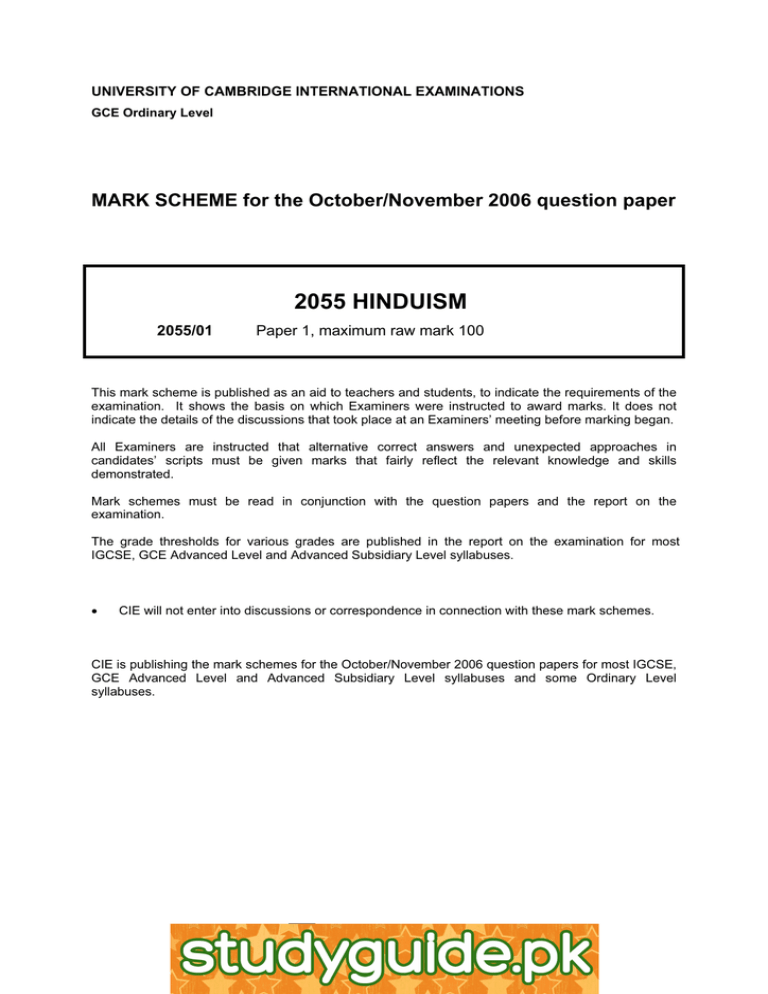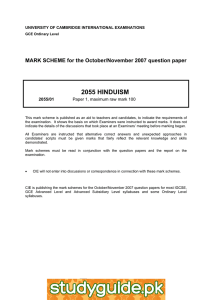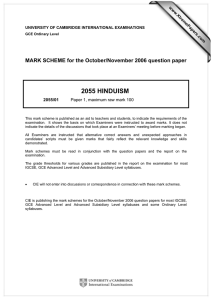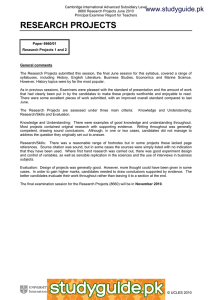2055 HINDUISM MARK SCHEME for the October/November 2006 question paper
advertisement

UNIVERSITY OF CAMBRIDGE INTERNATIONAL EXAMINATIONS GCE Ordinary Level MARK SCHEME for the October/November 2006 question paper 2055 HINDUISM 2055/01 Paper 1, maximum raw mark 100 This mark scheme is published as an aid to teachers and students, to indicate the requirements of the examination. It shows the basis on which Examiners were instructed to award marks. It does not indicate the details of the discussions that took place at an Examiners’ meeting before marking began. All Examiners are instructed that alternative correct answers and unexpected approaches in candidates’ scripts must be given marks that fairly reflect the relevant knowledge and skills demonstrated. Mark schemes must be read in conjunction with the question papers and the report on the examination. The grade thresholds for various grades are published in the report on the examination for most IGCSE, GCE Advanced Level and Advanced Subsidiary Level syllabuses. • CIE will not enter into discussions or correspondence in connection with these mark schemes. CIE is publishing the mark schemes for the October/November 2006 question papers for most IGCSE, GCE Advanced Level and Advanced Subsidiary Level syllabuses and some Ordinary Level syllabuses. www.xtremepapers.net Page 2 Mark Scheme GCE O LEVEL - OCT/NOV 2006 Syllabus 2055 Paper 01 1 Candidates should be able to gain a pass mark by relating the story in a way that shows basic understanding of the three gods mentioned, with their names, of the ‘yaksha’ and of the role Uma played in the story. Better answers should mention ‘allegory’ or an explanation of allegory, to ‘explain the meaning’ of the story in more general terms, i.e. the role of Wisdom in understanding God/Being. An excellent answer might mention the importance of this story in playing down the power of individual gods such as Indra. 2 The question mainly tests knowledge of the set texts, which candidates should be able to summarise in their own words without too much background narrative (i.e. details of the battle and of Arjuna’s anxieties). At this level they should at least be able to explain that the way of knowledge, though perhaps ‘superior’, is not for everyone. On the other hand if people choose the path of ‘works’ they must be careful to avoid attachment to the work itself and to the ‘fruits’ of their works if they are to gain God’s favour. 3 Knowledge of the text will enable candidates to answer the question, which they can do in a general way, but should also, for good marks, be able to relate to the particular stories specified in the Syllabus, e.g. the story of the boatman. For example they could note that in a general way the poet makes the story of Rama popular because it is in language accessible to many. In particular he opens up the idea of bhakti to all, by showing that even the poorest and most unworthy members of society can bring an acceptable offering. 4 As with all of the two-part questions, candidates should not be penalised if they do not write an equal amount about each, especially as they are asked to ‘compare’. On the other hand they should be careful here not to write a great deal more about Ganesha, since so many of that god’s attributes are tied to narratives. Good answers should recognise that both brothers are sons of Shiva, although in depictions of Shiva’s family Kartikeya often has a minor role or is absent altogether, yet in some areas of South India, for example, the cult of Lord Murugan takes precedence. Although the festivals associated with the two gods have some relevance, candidates should concentrate on ‘features and attributes’ rather than festivals here. 5 The highest marks for the question will be available to candidates who can emphasise the religious significance of what is said and done rather than merely describing preparations, food, rituals, etc. It is also important not to get too involved in ‘background stories’ such as the Ramayana story behind the celebration of Divali. Good candidates should be able to answer the question in a balanced way, showing the significance of the different symbols and rites involved in their chosen festival. 6 Candidates should show understanding of the concept of avataras, but should not embark on listing all the avataras of Vishnu and their stories. They could certainly contrast the figure of Krishna as, for example, the wise charioteer of Arjuna with the youthful Krishna of Surdasa’s poetry. The latter exemplifies the childlike qualities of godliness and the ‘play’ involved in the loving relationship between God and his worshippers. Good candidates should note that different aspects of God’s nature appeal to different groups of worshippers, all of whom will count as ‘devotees’. 7 The best essays should note that this question does not ask for a negative attitude to the traditional ashramas, but invites a positive re-evaluation of what is valuable in them, in the light of social developments in the present century. In some ways the needs of the elderly have not changed, but it is arguable that ways of easing the difficulties of old age have improved. In industrialised societies the economic state of the elderly might also be better, and they may be living longer and more healthily because their physical circumstances are improving. One important question concerns the responsibility that younger generations should feel towards their elderly family members, and how far their duty to older relatives extends if they are no longer ‘in the forest’ waiting for death. 8 The request for points ‘for’ and ‘against’ does not mean that the candidate cannot state a personal point of view, but that points on both sides should be known and can be discussed in the light of texts which have been studied. Traditional arguments would place the varna system in India’s earliest history, but some would argue that it is not essentially a Vedic requirement. Many have argued against a life determined by one’s social status at birth, and within Hinduism there have been reform movements aiming to limit the power of higher castes and particularly to deny untouchability. There is a persuasive argument, backed by sacred texts, that ‘one’s place’ in society depends on one’s moral growth and abilities, rather than simply the accident of birth. © UCLES 2006 www.xtremepapers.net Page 3 Mark Scheme GCE O LEVEL - OCT/NOV 2006 Syllabus 2055 Paper 01 9 The idea of ‘purusharthas’ should be well known and explained, and the significance of artha and kama in the ‘householder’ stage of life understood. Although ascetics have tended to bypass this stage, it is nonetheless normative in society, as the time when children are reared and businesses which are essential to any economy are built up. Candidates should note that kama and artha have to be seen in the context of responsible adult life and are not licensing avarice or promiscuous behaviour. 10 Some reference to Ramakrishna’s life and religious experiences is certainly relevant here, as long as candidates understand that the question refers to his insights as to the universal nature of religion in general. The ‘challenge’ was actually in tune with the spirit of the age, in that Indians had to come to terms with the Christianity of many of their British rulers and with the fact that there were sizeable minorities of religions other than Hinduism represented in India. Ramakrishna’s preaching, therefore, allowed the development of all India’s religions in the context of ‘world religions’ at a time when communications world-wide were becoming easier, although such liberal attitudes were themselves challenged by later reformers. 11 Candidates should have studied the reasons for the setting up of the organisation and the passionately held viewpoints of its founder and subsequent leaders. The call to return to ‘pure’ Vedic teaching could be reckoned as ‘reforming’, certainly in its intention. Broadly speaking, the social results of the reforming measures are the easiest to evaluate, especially in the areas of health, education and the treatment of women. Commentary on the present state of the Arya Samaj could be relevant, but for the bulk of the essay candidates should discuss it, as the question requires, in the historical context of its early years. 12 Biographical details about Gandhi will be relevant here, especially in (b), but only insofar as they are directly related to the question. For (a) candidates must do more than identifying ahimsa as ‘non-violence’: they must show how widely Gandhi understood this term, covering humans’ relationships with the physical world, the animal world and with people, individuals and groups. In (b) they should refer to details of his own life and his public teaching, such as his asceticism, his reverence for the cow and his struggle to free the oppressed at all levels in society. In doing this he attempted to show his beliefs in action. © UCLES 2006 www.xtremepapers.net



